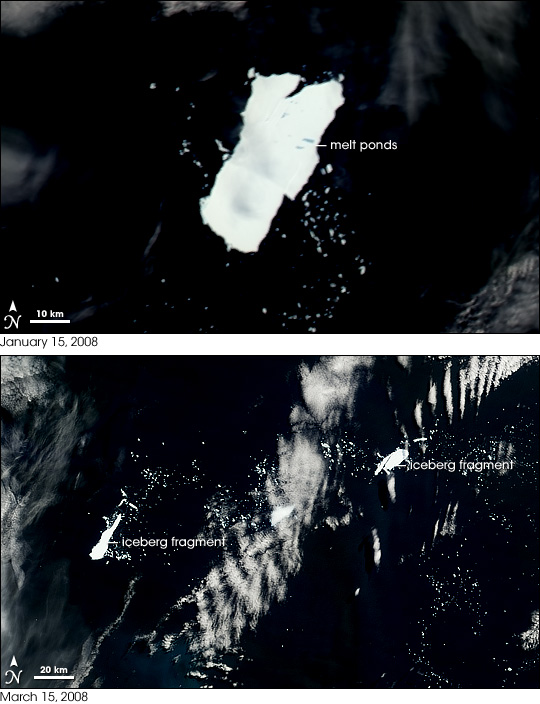


In April 2005, the A53a iceberg calved off the Larsen Ice Shelf on the Antarctic Peninsula and began drifting north. As it headed north, the iceberg encountered warmer temperatures and, nearly three years later, began to disintegrate. Observing such iceberg disintegration can help scientists studying Antarctica’s ice shelves better understand how those shelves change in response to warmer temperatures.
This pair of images was acquired by the Moderate Resolution Imaging Spectroradiometer (MODIS) sensors on NASA’s Aqua (top) and Terra (bottom) satellites. The top image was captured on January 15, 2008; the bottom image was captured on March 15, 2008. High-resolution images show this event in more detail, on January 15, February 21, March 1, March 3, and March 15.
In the January 15 image, the iceberg remains intact, although isolated pale blue melt ponds appear on the surface. These melt ponds are more conspicuous in an astronaut photograph, providing a foreshortened view of the iceberg, also taken on January 15. Melt ponds on the surface of the iceberg suggest that the iceberg may be approaching disintegration. Melt ponds contribute to disintegration because water can fill preexisting cracks on the iceberg’s surface and eventually carve all the way through the ice.
The March 15 image shows the iceberg after it broke in two near South Georgia Island in the Southern Atlantic. This image covers a wider area than the top scene since the iceberg pieces have drifted apart. The iceberg in the east is in the process of further fragmentation, and both icebergs have shed giant slivers of ice. MODIS captured the iceberg beginning to disintegrate on March 3, appearing in two pieces that remained close together.
When an iceberg drifts northward and encounters warmer temperatures, it breaks apart much faster than it would if it remained near Antarctica. Within a few years or even months, the iceberg can undergo changes that might take decades along the Antarctic Peninsula. Although iceberg disintegration in warmer conditions occurs faster, the basic melt and disintegration process is the same.
You can download a 250-meter-resolution KMZ file of the break-up of iceberg A53a suitable for use with Google Earth.
NASA image created by Jesse Allen, using data provided courtesy of the MODIS Rapid Response team. Caption by Michon Scott.